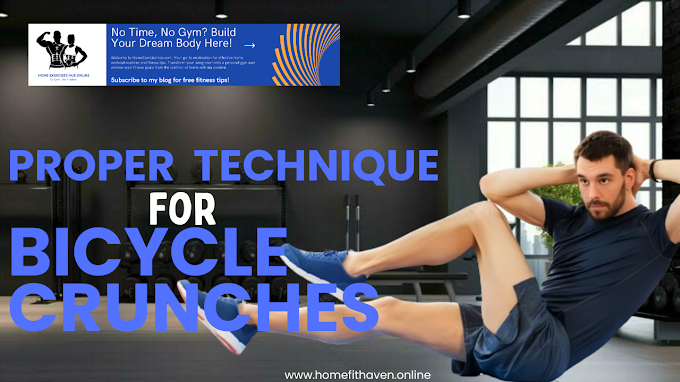Easy Upper Body Workout at Home
Dreaming of a toned body or sculpted body, but missing out on a gym membership? Home workouts are a great way to achieve your fitness goals without the crowds or travel. But a question arises: Do you need a gym buddy to "spot" you during your workout, like you might at the gym?
The answer is - not always! Here's how to navigate the world of "Spotter SOS" and find effective alternatives for safe and effective home workouts.
The Classic Gym Buddy: Friend or Fiction for Home Fitness?
Imagine this: You're pushing yourself to the limit during a set of squats, feeling your legs burn. Suddenly, you stagger a little. But fear not! Your trusty gym buddy is there to catch you and prevent potential messes. This is the role of the spotter in weight training!
But home workouts often include bodyweight exercises like squats, lunges, and push-ups. Since you are working with your own body weight, there is less risk of needing a spotter. However, there are situations where a partner can be beneficial:
The Perks of Partner Power:
- Motivation Matters: Having a workout partner can provide much-needed motivation, especially during tough workouts. They can add a social element and make your workout more enjoyable.
- Check out the form! A trusted friend can observe your form and offer pointers to make sure you're doing the exercises correctly, potentially preventing injuries down the line.
- Heavy lifts at home: For advanced exercises that involve heavy weights or challenging positions, having a spotter can provide an extra layer of peace of mind and safety.
But What if You Go Solo? Ditching the Spotter Doesn't Mean Ditching Safety!
Many home workouts focus on bodyweight exercises or light weights. So, if you're flying solo, here are some alternatives to ensure a safe and effective sweat session:
- Focus on form first: Home workouts are a great opportunity to master proper form. This reduces the risk of needing someone to catch the dropped weight and helps you achieve maximum results.
- Start light, shine bright: If you're using dumbbells or kettlebells, start with light weights and gradually increase as you get stronger. This reduces the risk of needing assistance to complete the rep.
- Listen to your body (it's your best friend!): This cannot be emphasized enough! Pay attention to your body's signals. If you feel shaky or unsure, stop, rest, or modify the exercise. There's no need to set yourself up for failure when working alone.
- Invest in quality equipment: Use sturdy dumbbells, kettlebells, or resistance bands that are in good condition and appropriate for your fitness level. Bad equipment is a recipe for disaster.
- Master Modifications: Don't be afraid to modify exercises to suit your fitness level. Most exercises have simple variations that are just as effective and safe to perform solo.
- Use caution with advanced movements: If you're unsure about an advanced exercise, err on the side of caution and choose an easier variation or skip it altogether. There are many other exercises that can safely target the same muscle groups.
Building Confidence in Your Solo Sweat Sessions:
Working alone can feel difficult at first. Here's how to boost your confidence and get the most out of your solo home workouts:
- Set realistic goals: Achievable goals keep you motivated and celebrate small victories! Track your progress to see how far you've come.
- Create a fun space: clear a corner, invest in a yoga mat, add some motivational posters or upbeat music. A dedicated workout space sets the stage for a positive and productive sweat session.
- Embrace the challenge: Challenge yourself with new exercises or variations as you progress. It keeps things exciting and helps you avoid plateaus, boosts your confidence and pushes you to reach your full potential.
The Homefithaven.online Lifeline – Your Partner in Safe and Effective Home Workouts!
Ready to ditch the spotter (or find a virtual one!) and achieve your fitness goals from the comfort of your own home? Homefithaven.online is here to help! Why we are your ideal partner:
- Extensive Exercise Library: Explore a wide range of bodyweight and weight-bearing exercises, categorized by muscle group, fitness level, and equipment required.
- Workout plans and routines: Choose from pre-designed workout plans tailored to your goals, whether it's building muscle, burning fat, or improving flexibility.
- Expert Guidance: Our team of fitness professionals provide valuable articles, tips and guides to help you master proper form, avoid injuries and optimize your home workouts.
Safety Tips for Solo Home Workouts (Without a Spotter!)
Even without a spotter, safety is paramount to a successful home workout. Here are some additional tips to keep you safe and injury-free:
- Warm-up and cool-down: Always start with a 5-10 minute dynamic warm-up to prepare your body for exercise. This can include light cardio, jumping jacks, arm rings and leg swings. Likewise, cool down with static stretches for at least 5-10 minutes after exercise to improve flexibility and reduce muscle soreness.
- Maintain proper form: This is vital to prevent injuries and maximize results. If you struggle to maintain proper form, don't be afraid to lose weight or modify your workout.
- Focus on controlled movements: Avoid jerking or bouncing movements during exercises. Focus on slow and controlled movements for both the lifting and lowering phases of each exercise.
- Don't push yourself too hard: It's important to go slowly, especially when starting out. Avoid pushing yourself to exhaustion or failure, which can lead to injuries.
- Invest in a fitness tracker : Track your workouts and monitor your progress. This can help you stay active and avoid overtraining.
Spotter Alternatives: Tech Takes Center Stage!
In today's tech-driven world, there are modern alternatives to having a physical spotter during your home workout:
- Smart workout apps: Several apps offer exercise routines with video demonstrations and form checks. Some even provide real-time feedback on your technique, making sure you perform exercises safely and effectively.
- Virtual Trainers: Consider online personal training sessions. A virtual trainer can create a personalized workout plan, monitor your form remotely, and offer guidance during your workout.
- Wearable fitness trackers: These can track your heart rate, reps and sets during your workout. Some also offer audio prompts for proper form and rest periods.
Building a Supportive Home Workout Community: It's Not All About the Physical!
- Follow Fitness Influencers: Find social media fitness influencers who inspire you. Learn new exercises, get workout ideas, and stay motivated on their journey.
- Workout with a virtual partner: Some online fitness platforms offer live or pre-recorded workouts with virtual partners who can provide guidance and motivation.
- Team up with a long-distance friend: If you have a friend who also enjoys working out at home, consider scheduling a virtual workout session together. You can motivate each other, make sure you stay on track, and even add an exciting competitive element to your workouts.
The Power of Consistency and Setting Goals
- Schedule your workout: Treat your home workout like any other important appointment. Block out time in your calendar and stick to it as much as possible.
- Set Smart Goals: Make your goals specific, measurable, attainable, relevant, and time-bound. Instead of just saying "get in shape," "lose 5 pounds in 3 months" or "complete 3 total body workouts per week."
- Track Your Progress: Seeing your progress is a great motivator! Record your workouts, track your weight or measurements, or use a fitness tracker.
- Celebrate your successes: Did you count new reps? Did you walk a long distance? Celebrate those milestones, big or small! It reinforces positive behaviors and keeps you motivated.
- Find what works for you: There is no one-size-fits-all approach. Experiment with different exercise formats, find exercises you enjoy, and create a routine you can stick with.











